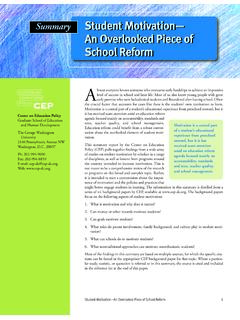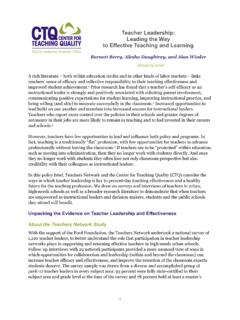Transcription of School Dropout Prevention - American Psychological …
1 American Psychological Association. (2012). Facing the School Dropout dilemma. Washington, DC: Author. Retrieved from 1 Facing the School Dropout Dilemma The UN Convention on the Rights of the Child states that every child has the right to an education that develops their personality, talents and mental and physical abilities to their fullest potential. According to the Alliance for Excellent Education (AEE) (2011), an estimated million American high School students drop out every year; a disproportionate number of whom are youth of color.
2 The nation s children are its future workers, citizens, and leaders. Education remains the major tool by which people become empowered and the economic, social, and personal well-being of all citizens in a pluralistic society increases. A high Dropout rate diminishes the pool of qualified people from diverse backgrounds who will enter the professional and political ranks that make important public policy decisions (APA, 1996). The mission for every School should be to educate students to equip them to become knowledgeable, responsible, socially skilled, healthy, caring, and contributing citizens (Greenberg et al.)
3 , 2003). The fact that so many students never complete high School has a deep and wide-ranging impact on the s long-term economic outlook. The Department of Education, National Center for Education Statistics (NCES) (2011) reports that the median income of persons ages 18 through 67 who had not completed high School was roughly $25,000 in 2009. At current rates, a significant segment of the population will remain entrenched in poverty while on a global scale the competitiveness of the American labor force will continue to lag behind.
4 APA has a longstanding commitment to School Dropout Prevention as is evident from its 1996 resolution on the topic (APA, 1996). Who is dropping out? NCES reports that on average, percent of students who were enrolled in public or private high schools in October 2008 left School before October 2009 without completing a high School program. Broken down by race, the estimated event Dropout rates were for Whites, for African Americans, and for Latinos. NCES did not find a significant difference in the 2009 event Dropout rates for males and females.
5 In terms of age, older students (ages 20 through 24) are at a greater Dropout risk than students aged 15 through 17. A strong link exists between poverty and high School Dropout rates. Students from low-income families dropped out of high School five times more than students from high-income families in 2009. The term Dropout factories was coined to refer to high schools that graduate 60 percent or less of their students. Those schools produce 50% of the nation s dropouts and two-thirds ethnic minority dropouts according to the Alliance for Excellent Education (2011).
6 The dropouts are highly influenced by poverty in the School locations. Dropout factories are mainly found in 15 states primarily in the North, West, and South of the (Balfanz & Legters, 2004). These schools are only 12% of the national total yet they are estimated to produce about half of the nation s dropouts overall (Balfanz & Legters, 2004). Slight good news is that Dropout factories American Psychological Association. (2012). Facing the School Dropout dilemma. Washington, DC: Author. Retrieved from 2 have continued to decline; estimated at in 1,634 in 2009 compared to 2,007 in 2002 and 1,746 in 2008, according to America s Promise Alliance (2011).
7 However, an estimated million students still attend Dropout factories as of 2009; 183,701 students fewer than in 2008 (America s Promise Alliance, 2011). The overriding common characteristic for these schools is location in poverty-stricken areas with high rates of unemployment, crime, and ill health. In addition, their student bodies are comprised disproportionately of children of color (Balfanz & Legters, 2004). More than 60 percent of black students attend schools where more than 50 percent of the School population is identified as living in poverty, compared to 18 percent of white students (Alliance for Excellent Education, 2011).
8 Approximately 42 percent of Hispanic students, 43 percent of African American , and 46 percent of American Indian students will not graduate on time with a regular diploma, compared to 17 percent of Asian students and 22 percent of white students (AEE, 2011). These Dropout factories are estimated to produce 81% of Native American , 73% of African American , 66% of Latino, and 34% of White dropouts respectively (Balfanz, 2007). Ethnic minority students who are fortunate enough to attend middle class or affluent high schools are promoted to the 12th grade at similar rates as their White peers (Balfanz & Letgers, 2006).
9 However, nearly half of the nation s African American and Latino students attend high schools in low-income areas with Dropout rates that hover in the 40-50% range (Balfanz & Letgers, 2006; Children s Defense Fund, 2004). There is no single prominent risk factor predicting Dropout . Rather, there are numerous risk factors that in combination with each other raise the probability of youth leaving high School early (Gleason & Dynarski, 2002). These factors fall into four broad categories related to individuals ( , truancy, poor School attitude), families ( , low-income, lack of parental involvement), schools ( , negative School climate, low expectations), and communities ( , high crime, lack of community support for schools), according to the Center for Mental Health in Schools, UCLA (2007).
10 Dropout rates particularly correlate with high poverty rates, poor School attendance, poor academic performance, grade retention ( , being held back), and disengagement from School (Hammond, Linton, Smink & Drew, 2007). Fortunately, there is a growing and encouraging body of research for schools on how to prevent Dropout by addressing problem behaviors, promoting academic success, and enhancing overall health and wellbeing for students. The importance of early education and early literacy Research is discovering that dropouts arise from an accumulation of various risk factors throughout children s schooling that peak once in high School .
















